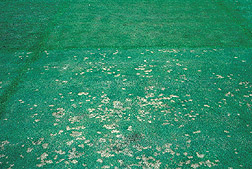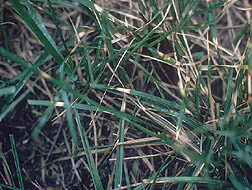An Organic Cure for a Turfgrass Disease?
|
|
|
|
Golf courses in the United States spend tens of millions of dollars each year on fungicides to control the turfgrass disease called dollar spot. First appearing as small, unsightly spots of dead grass, the diseased areas eventually merge and cover large areas. The cause of dollar spot is a fungus calledSclerotinia homoeocarpa.
Chemical fungicides for dollar spot may someday be replaced by an organic inoculation consisting of beneficial soil microorganisms as the first choice, thanks to University of Missouri-Columbia (MU) student Matthew T. Wood, who became interested in ARS microbiologist Robert J. Kremer's experiments on biological weed control. Kremer discovered that the highest numbers of weed-suppressing microbes in fields were found where crops were rotated, chemicals and tillage were minimal, and organic materials, like compost, were added. While an undergraduate, Wood and his adviser, MU turfgrass researcher Eric H. Ervin, envisioned that soil could be managed to maintain a healthy mix of microbes that would suppress growth of the dollar spot pathogen. If so, suburban lawnkeepers and golf course managers could reduce the input of pesticides into the environment. |
|
|
Wood received a $1,000 stipend from the MU College of Agriculture, Food, and Natural Resources (CAFNR), to work with Kremer and Ervin, studying the biocontrol ofS. homoeocarpa. The CAFNR On-Campus Research Internship provides opportunities for aspiring undergraduate students to gain firsthand experience in a research project under the mentoring of a researcher.
"Our research project showed that a multiculture of compatible anaerobic and aerobic microorganisms slowed development of dollar spot on creeping bentgrass in the greenhouse," says Kremer. The success may pique interest in further research on ways to reproduce a similar lasting beneficial effect in soils already teeming with microflora. In theory, says Kremer, if microbes in the mixed cultures coexist with native soil microorganisms, applying the mixture to soil might ensure establishment of cultures that would enhance the beneficial effects of biological processes, including growth suppression of fungal pathogens. Such cultures have been named "effective microorganisms," or EM, by Teruo Higa, professor of horticulture at the University of the Ryukyus, Okinawa, Japan. Higa's studies also inspired Wood's experiments. For laboratory and greenhouse studies, the researchers locally obtained an EM liquid culture of bacteria, yeasts, and algae. Wood then grew the mixture of microbes on horse manure, brewery waste, wheat bran, and charcoal to make a material known in Japan as bokashi. He grewS. homoeocarpa on heat-sterilized millet seeds to produce an inoculum used to infect 4-week-old bentgrass seedlings growing on sand mixtures with and without bokashi amendments. In the greenhouse experiments, 8 weeks after bentgrass seeding,Sclerotinia had infected less than 1 percent of the turf in the pots that contained six parts sand to four parts EM-bokashi. But in the control pots, containing only sand (90 percent) and peat (10 percent), 19 percent of the turf became infected. As principles of microbial effects on disease and weed suppression are learned, says Kremer, the potential for increasing the production and use of EM organic amendments may be realized. Recyclable materials to support EM growth are abundant. Ultimate benefits may include more efficient use of manure, food wastes, sawdust, and woodchips.—By Ben Hardin, Agricultural Research Service Information Staff. This research is part of Soil Resource Management (#202) and Crop Protection and Quarantine (#304), two ARS National Programs described on the World Wide Web at http://www.nps.ars.usda.gov. Robert J. Kremer is in the USDA-ARS Cropping System and Water Quality Research Unit, University of Missouri, Natural Resources Building, Room 302, Columbia, MO 65211; phone (573) 882-6408, fax (573) 884-5070. |
|
"An Organic Cure for a Turfgrass Disease?" was published in the August 2001 issue of Agricultural Research magazine. |
|








